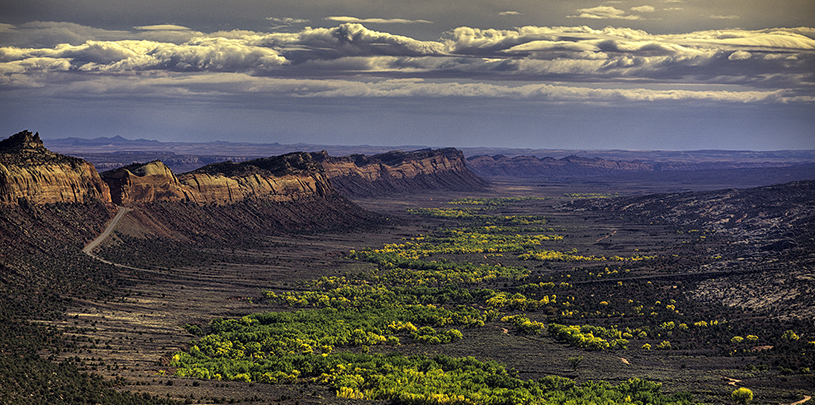
 by Tim Peterson, Cultural Landscapes Director
by Tim Peterson, Cultural Landscapes Director
Lawsuits take time. When they involve issues you care deeply about, it seems like they take an extra-long time. As we wait for the courts to advance to the next stage of our litigation challenging the president’s unlawful actions in 2017 revoking and replacing Bears Ears and Grand Staircase-Escalante national monuments, positive signs in other court cases with similar fact patterns, new research, and a poor record of success for the administration are giving us hope for encouraging outcomes.
On Friday, March 29, 2019, in Alaska, U.S. District Judge Sharon Gleason ruled that an executive order signed by President Trump opening the Arctic Ocean to oil and gas leasing was “unlawful and invalid.” President Trump’s April 2017 order would have reversed bans on new oil and gas leasing put in place in 2015 and 2016 by former President Obama for about 125 million acres under the Arctic Ocean and certain parts of the Atlantic Ocean. President Obama prohibited new oil and gas drilling using his authority under a 1953 law called the Outer Continental Shelf Lands Act. Restoring the bans, the judge ruled that Trump’s orders “…exceeded the President’s authority” when he tried to open the protected waters to new drilling.
Just like the Antiquities Act of 1906 (the law that was used to create Bears Ears and Grand Staircase-Escalante national monuments), the Outer Continental Shelf Lands Act grants limited and one-way protection authority to presidents, but it does not grant the authority to undo protections. Just as we hope the judge in our monuments cases will rule, Judge Gleason ruled that the law does not give presidents the authority to revoke withdrawals made by their predecessors.
Staff for House Committee on Natural Resources Chairman Raúl Grijalva said of the ruling: “…only Congress can remove presidentially established protective features - a bad sign for Trump’s order shrinking Utah’s Bears Ears and Grand Staircase-Escalante national monuments, which is itself being challenged in multiple federal cases." This was indeed good news, but more news was just around the corner.
“I do think, by the way, that the supporters of Bears Ears National Monument will win in court.”
- Former Interior Secretary Sally Jewell
On April 2, 2019, a magistrate judge in Oregon ruled that President Obama did not exceed his authority under the Antiquities Act when, in 2017, he expanded Cascade-Siskiyou National Monument, known for its astounding diversity of wildlife and plants. The challenge was brought by a timber and land speculation company, claiming the expansion was invalid because some of the trees there were previously set aside for logging under the Oregon and California Lands Act. The court upheld the legitimacy of the monument, confirming that the Oregon and California Lands Act does not conflict with the Antiquities Act of 1906, which grants presidents the authority to designate national monuments on public lands. Two other lawsuits challenging Cascade-Siskiyou are still pending, but this ruling affirming the legitimacy of President Obama’s protective action is an encouraging first step.
During the first week of April, the Harvard University Environmental Law Review published “the first and only comprehensive review of every prior national monument reduction that occurred as a result of presidential action.” University of Utah law research professor John Ruple said that his research “demonstrates that there is no historical precedent for Trump’s reductions…there is little evidence indicating that Congress intended to endow the president with the power to dramatically reduce national monuments. Instead, Congress appeared intent on retaining those powers for itself.”
Ruple further concludes that those who dislike presidential national monument designations are “not without a remedy, but that remedy resides in the halls of Congress, which unquestionably has the power to create, modify, or even revoke national monument designations. There is no reason to expand the power of the president by creating implied powers that are supported neither by history nor by law.” Powerful words.
Much ink has been spilled on the administration’s no-holds-barred push to undo policy and regulation, and the attack has indeed been swift and comprehensive. But, so far, cutting out public involvement, lack of due diligence, downright sloppiness, and failure to back up policy changes with facts and evidence have had a dismal effect on the staying power of the Trump administration’s policy pronouncements. The current administration’s success rate defending its deregulatory agenda in court? About 6 percent.
Is this losing trend good news for Bears Ears and Grand Staircase-Escalante? If past is prologue, yes it is. As Tom Petty sang, the waiting is the hardest part. But, with developments like these, good things may come to those who wait.
On October 8, 2021, President Biden restored Bears Ears and Grand Staircase-Escalante national monuments. Send a thank you to President Biden today.
80% of Arizona voters support Baaj Nwaavjo I'tah Kukveni National Monument, according to a new poll.
Read MoreUtah voters strongly support national monuments in general, and Bears Ears and Grand Staircase-Escalante in particular, a new poll shows.
Read MoreA small victory in the legal case challenging Daneros uranium mine, near Bears Ears National Monument.
Read More